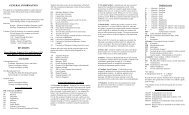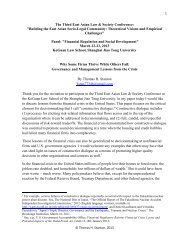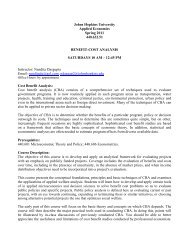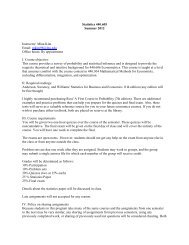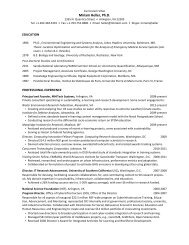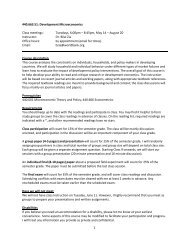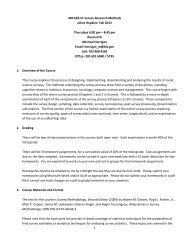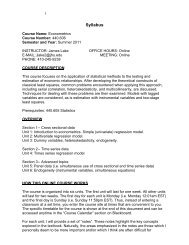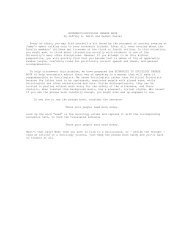Principles and Applications of Energy Technology - Advanced ...
Principles and Applications of Energy Technology - Advanced ...
Principles and Applications of Energy Technology - Advanced ...
Create successful ePaper yourself
Turn your PDF publications into a flip-book with our unique Google optimized e-Paper software.
Syllabus <strong>and</strong> ReadingsGeneral CommentThe classes will follow the syllabus below quite closely, with the following caveats. Depending on classinterest <strong>and</strong> level <strong>of</strong> discussion some topics may take slightly longer or shorter than suggested by thesimple to 1 to 12 numbering. In particular wind <strong>and</strong> solar are both closer to about 1.5 to 2 classes each[where each class is assumed to be 2 hrs <strong>and</strong> 45 minutes with a few brief breaks], which is <strong>of</strong>fset in part inthe syllabus with some other topics occupying less than a class (e.g. which applies to both carbon capture<strong>and</strong> sequestration (CCS) <strong>and</strong> electricity storage). Conventional generation, which includes coal, nuclear<strong>and</strong> natural gas generation, <strong>and</strong> includes discussions <strong>of</strong> real <strong>and</strong> idealized “heat engines” covers about 2classes (<strong>and</strong> possibly a little more) as indicated by (6&7).1: Introduction <strong>and</strong> <strong>Energy</strong> Supply <strong>and</strong> Dem<strong>and</strong>: United States <strong>and</strong> WorldwideThis part <strong>of</strong> the course provides an overview <strong>of</strong> the topics <strong>and</strong> major issues to be addressed in the course,as well as a discussion <strong>of</strong> course mechanics <strong>and</strong> a brief introduction to the related reading materials. Theclass will then review energy supply <strong>and</strong> consumption from both a U.S. <strong>and</strong> international perspective,with a view to framing some <strong>of</strong> the major environmental challenges, especially associated withcontrolling future carbon emissions, <strong>and</strong> the likely need for a portfolio approach to reduce emissions.The class will also cover energy conversion units <strong>and</strong> a review <strong>of</strong> some <strong>of</strong> the fundamental scientificprinciples associated with energy, such as energy conservation.Pacala S. <strong>and</strong> Socolow, R. “Stabilization Wedges: Solving the Climate Problems for the Next 50 yearswith Current <strong>Technology</strong>” Science, 305, August 2004. 4<strong>Energy</strong> Information Administration, International <strong>Energy</strong> Outlook 2011 – presentation.http://www.eia.gov/pressroom/presentations/howard_09192011.pdfHoldren, John P., “The <strong>Energy</strong> Innovation Imperative: Addressing Oil Dependence, Climate Change<strong>and</strong> Other 21 st Century Challenges”, Innovations, MIT Press, Spring 2006. (Optional)http://www.mitpressjournals.org/doi/pdf/10.1162/itgg.2006.1.2.3<strong>Energy</strong> Science (Andrews <strong>and</strong> Jelley (2007)). Chapter 1 - Introduction: Sections 1.1, 1.2, 1.3 <strong>and</strong> 1.4. 52: Climate Change: Introduction to the Science <strong>and</strong> Framing <strong>of</strong> the Economics <strong>and</strong>Policy ChoicesAn overview <strong>of</strong> what climate change means from both a science <strong>and</strong> policy perspective. Specifically, itwill cover what is known <strong>and</strong> what is uncertain about climate change <strong>and</strong> how it relates to anthropogenicemissions. Much <strong>of</strong> the rest <strong>of</strong> the course will discuss various energy technologies, the implementation<strong>and</strong> operation <strong>of</strong> which may have a significant impact on mitigating future green house gas (GHG)4 Initially it will be sufficient to skim through this paper, <strong>and</strong> read it more deeply as we go through the course.5 The specific sections to be read from Chapters in <strong>Energy</strong> Science: Andrews <strong>and</strong> Jelley (2007) will be specifiedin class several weeks ahead <strong>of</strong> their use. The readings for the first four classes are included above. Thesections (e.g., 2.1, 2.2 (<strong>and</strong> so on )sometimes include more technical “derivation” boxes (in blue); thesederivations are not required reading or part <strong>of</strong> the course, unless explicitly noted. Sections are usually quiteshort typically ranging from half a page to 2 pages in lengthDRAFT, August 23 rd 2012 (original version January 11, 2010, <strong>and</strong> previously updated August 24, 2010 <strong>and</strong>May 20 , 2011, <strong>and</strong> January 6, 2012). Based in part with modifications on course instructor developed forEnvironmental Challenges for <strong>Energy</strong> <strong>Technology</strong> <strong>and</strong> Policy (Original syllabus drafted September 1 st 2008,updated August 15 th 2009)





